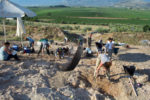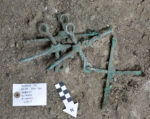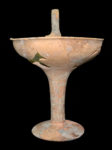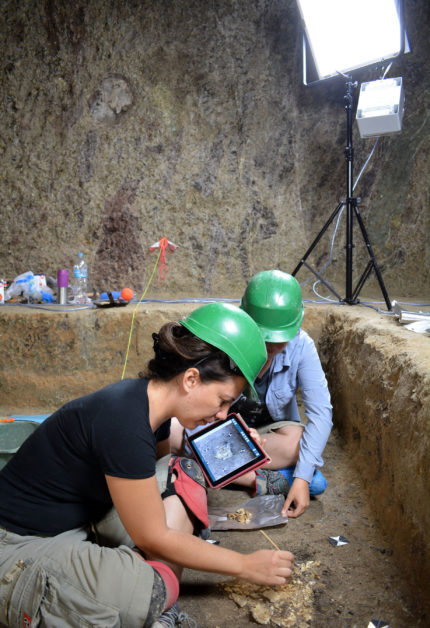 Archaeologists have discovered one of the largest tombs of the Mycenaean era in Orchomenos, Greece. The burial chamber is an estimated 3,350 years old, dating to the 14th century B.C. and is the ninth-largest Mycenaean chamber tomb of the 4,000 known to have been excavated in the last century and a half.
Archaeologists have discovered one of the largest tombs of the Mycenaean era in Orchomenos, Greece. The burial chamber is an estimated 3,350 years old, dating to the 14th century B.C. and is the ninth-largest Mycenaean chamber tomb of the 4,000 known to have been excavated in the last century and a half.
It is of monumental scale, with a road 20 meters (66 feet) long carved of out of stone leading into the tomb. The burial chamber is a single large room 42 square meters (452 square feet) in surface area. The walls were topped by a stone roof that was originally around 3.5 meters (11 feet) high. That figure is an estimate because the roof collapse in antiquity, perhaps even shortly after it was constructed in the Mycenaean era.
 The cave-in damaged some of the artifacts and human remains inside the tomb, but it also saved it from a far worse danger than architectural failure or natural disaster: human beings. Covered by the collapsed pile of rocks, the tomb was hidden from looters and from well-meaning people who might seek to reuse the tomb, a very common practice in ancient Greece. That makes this find extremely valuable to archaeologists, because they can learn so much about a single identified point on the timeline without concern that later interventions have contaminated the scene. It will be one of the best documented Mycenaean tombs ever found on the Greek mainland.
The cave-in damaged some of the artifacts and human remains inside the tomb, but it also saved it from a far worse danger than architectural failure or natural disaster: human beings. Covered by the collapsed pile of rocks, the tomb was hidden from looters and from well-meaning people who might seek to reuse the tomb, a very common practice in ancient Greece. That makes this find extremely valuable to archaeologists, because they can learn so much about a single identified point on the timeline without concern that later interventions have contaminated the scene. It will be one of the best documented Mycenaean tombs ever found on the Greek mainland.
 The remains discovered inside the tomb are of an adult male, about 40-50 years old. He was buried with a selection of expensive and meaningful objects: more than 10 tin vessels, a pair of bronze hooks from horseshoes, bow fittings, arrows, brooches, jewelry, a seal ring, pottery and more. Because there are no other people buried there — almost unheard of with monumental Mycenaean tombs which were usually built to accommodate multiple family members over the course of generations — archaeologists are in the unique position of being able to associate every artifact with the one man interred in the chamber.
The remains discovered inside the tomb are of an adult male, about 40-50 years old. He was buried with a selection of expensive and meaningful objects: more than 10 tin vessels, a pair of bronze hooks from horseshoes, bow fittings, arrows, brooches, jewelry, a seal ring, pottery and more. Because there are no other people buried there — almost unheard of with monumental Mycenaean tombs which were usually built to accommodate multiple family members over the course of generations — archaeologists are in the unique position of being able to associate every artifact with the one man interred in the chamber.
It has already upended some of the received wisdom on Mycenaean funerary practices.
Finding this burial site and its features will give researchers the opportunity to better understand the burial practices of the region during the Mycenaean times. For example, the deposition of many jewels on a man-made burial contests – as in the case of a centuries-old warrior from Pylos found in 2015 – the widespread belief that the jewelry was mostly accompanied by women in their last home. It is also noteworthy that, with the exception of two small false amphoras, no Mycenaean ceramics were found in the grave, which, moreover, is extremely popular in this period.
This was a great way to inaugurate the first year of a five-year collaboration between the Greek Culture Ministry, the Ephorate of Antiquities of Viotia, the British School of Athens and the University of Cambridge. The interdisciplinary program combines excavation with osteoarchaeological study to find out more about the Mycenaean era. The discovery of the tomb dovetails perfectly with the program’s mission.
 Orchomenos in the southeastern Greek province of Boetia traced its founding back to the mythological king Minyas, described as the son of an array of different deities and demigods depending on which account you read. He moved his people inland from Thessaly and established a new royal dynasty in a new capital. Heracles burned it down once in a fight against the Minyan king who was exacting heavy tribute from the Greeks.
Orchomenos in the southeastern Greek province of Boetia traced its founding back to the mythological king Minyas, described as the son of an array of different deities and demigods depending on which account you read. He moved his people inland from Thessaly and established a new royal dynasty in a new capital. Heracles burned it down once in a fight against the Minyan king who was exacting heavy tribute from the Greeks.
Whatever the kernel of truth in the city’s origin myth, by the Mycenaean era Orchomenos was a center of wealth and civilization. It had a grand palace with elaborately frescoed walls, monumental tombs and ambitious infrastructure projects. The wetlands of nearby Lake Copaïs were drained to reclaim the fertile land for agriculture.
 At its peak in the 14th and 13th centuries B.C., Orchomenos was comparable in prosperity and pomp to Thebes, the most important city in Mycenaean Greece. Its rise was halted in the 12th century B.C. when the city was razed — archaeological remains attest to Orchomenos being devastated by fire — but it was rebuilt successfully enough to reengage its rivalry with Thebes. That’s what did them in the end, internecine warfare. It was sacked repeatedly by Thebes and its allies in the 4th century B.C., and while it was rebuilt by Philip II of Macedon and his son, the future Alexander the Great, in 335 B.C., it never recovered its former significance. Under the Roman Empire and the Byzantine, Orchomenos had declined into just another sleepy little town among many, albeit one with an excellent theater courtesy of the Macedons.
At its peak in the 14th and 13th centuries B.C., Orchomenos was comparable in prosperity and pomp to Thebes, the most important city in Mycenaean Greece. Its rise was halted in the 12th century B.C. when the city was razed — archaeological remains attest to Orchomenos being devastated by fire — but it was rebuilt successfully enough to reengage its rivalry with Thebes. That’s what did them in the end, internecine warfare. It was sacked repeatedly by Thebes and its allies in the 4th century B.C., and while it was rebuilt by Philip II of Macedon and his son, the future Alexander the Great, in 335 B.C., it never recovered its former significance. Under the Roman Empire and the Byzantine, Orchomenos had declined into just another sleepy little town among many, albeit one with an excellent theater courtesy of the Macedons.

Ages ago, I visited Mycenae and saw their massive ‘Tholos’ style tomb (= dome, sometimes referred to as ‘beehive’) with an interior height of 13.5m (44.3ft) and a diameter of 14.5m (47.6ft), a.k.a. the ‘Treasury of Atreus’.
So far, I was under the impression that Mycenae was in fact the most important city in Mycenaean Greece. The truth, however, seems to be that we are dealing here with ‘city states’, and e.g. the much later ‘important’ Athenians frowned upon Boeotians (Βοιωτία or ‘cattle region’) as ‘Hillbillies’. Their role in the -likewise much later- Persian invasion also seems to have been a different one.
The tomb in question here, being a ‘chamber’, does not really seem to be a ‘Tholos’, does it ? In Orchomenos, there is also a tomb dubbed as ‘Θολωτός τάφος του Ορχομενού’ (Tholos grave of Orchomenos) and ‘Θησαυρός του Μινύα’ (Treasury of Minyas). Thus, either Orchomenos, Minyas or somebody else -maybe all of them?- might have been buried there.
:hattip:
—————-
PS: Those ‘horseshoe nails’ might be ‘Gag bit’ bridles for horses .. or cows. How are ‘bronze hooks’ supposed to work on horseshoes ?
Ages ago, I visited Mycenae and saw their massive ‘Tholos’ style tomb (= dome, sometimes referred to as ‘beehive’) with an interior height of 13.5m (44.3ft) and a diameter of 14.5m (47.6ft), a.k.a. the ‘Treasury of Atreus’.
So far, I was under the impression that Mycenae was in fact the most important city in Mycenaean Greece. The truth, however, seems to be that we are dealing here with ‘city states’, and e.g. the much later ‘important’ Athenians frowned upon Boeotians (Βοιωτία or ‘cattle region’) as ‘Hillbillies’. Their role in the -likewise much later- Persian invasion also seems to have been a different one.
The tomb in question here, being a ‘chamber’, does not really seem to be a ‘Tholos’, does it ? In Orchomenos, there is also a tomb dubbed as ‘Θολωτός τάφος του Ορχομενού’ (Tholos grave of Orchomenos) and ‘Θησαυρός του Μινύα’ (Treasury of Minyas). Thus, either Orchomenos, Minyas or somebody else -maybe all of them?- might have been buried there.
:hattip:
————
PS: Those ‘horseshoe nails’ might be ‘Gag bit’ bridles for horses .. or cows ?. How are ‘bronze hooks’ supposed to work on horseshoes ?
Is it routine nowadays to try to recover DNA from remains like this?
what am i doing wrong :ohnoes: (3rd try)
——-
Ages ago, I visited Mycenae and saw their massive ‘Tholos’ style tomb (= dome, sometimes referred to as ‘beehive’) with an interior height of 13.5m (44.3ft) and a diameter of 14.5m (47.6ft), a.k.a. the ‘Treasury of Atreus’.
So far, I was under the impression that Mycenae was in fact the most important city in Mycenaean Greece. The truth, however, seems to be that we are dealing here with ‘city states’, and e.g. the much later ‘important’ Athenians frowned upon Boeotians (Βοιωτία or ‘cattle region’) as ‘Hillbillies’. Their role in the -likewise much later- Persian invasion also seems to have been a different one.
The tomb in question here, being a ‘chamber’, does not really seem to be a ‘Tholos’, does it ? In Orchomenos, there is also a tomb dubbed as ‘Θολωτός τάφος του Ορχομενού’ (Tholos grave of Orchomenos) and ‘Θησαυρός του Μινύα’ (Treasury of Minyas). Thus, either Orchomenos, Minyas or somebody else -maybe all of them?- might have been buried there.
———-
PS: Those ‘horseshoe nails’ might be ‘Gag bit’ bridles for horses .. or cows?. How are ‘bronze hooks’ supposed to work on horseshoes ?
Minyas’ tomb perhaps???
Those ‘horseshoe nails’ look more like a bit to me. Clarence is right. Cattle typically do not have anything in their mouths; they usually have nose rings or halters.
I disagree, those ‘horseshoe nails’ clearly indicate that we are dealing with an early Edward Scissorhands here. :giggle: